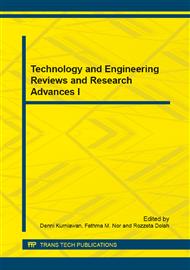p.109
p.117
p.122
p.128
p.141
p.145
p.149
p.154
p.159
Correlation of Stiffness and Natural Frequency of Precast Frame System
Abstract:
The main objective of this study was to obtain the correlation between the severity of damage to the stiffness of the frame in the format of its intrinsic dynamic properties, the natural frequency of the structural system at damaged and undamaged state. In this research, a laboratory test was performed on the precast post-tension frame of a similar dimension and strength specification to Jabatan Kerja Raya (JKR) school buildings. The modal frame is a reduced in scale of 1 to 5 and subjected to cyclic lateral loadings and monitored its frequency through vibration test. The vibration test was performed at each end of the cycle of a lateral pushover test. The vibration data was recorded by accelerometers due to external forced vibration to assess its natural frequency, mode shapes and damping values of the system. This research found that there is a physical tangible relationship between natural frequency changes and stiffness in the frame. The results showed that as the severity of damage increases, the natural frequency of the frame decreases significantly, indicating that softening of the system that lead to a favorable ductility for earthquakes.
Info:
Periodical:
Pages:
141-144
Citation:
Online since:
February 2015
Price:
Сopyright:
© 2015 Trans Tech Publications Ltd. All Rights Reserved
Share:
Citation:


